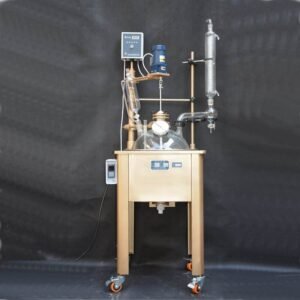Understanding material differences in reactor design for optimized laboratory performance
In the realm of modern laboratory and industrial chemistry, the selection of reactor material significantly influences the safety, efficiency, and reproducibility of chemical processes. One common technical debate focuses on the use of glass reactor vs stainless steel reactor, a subject that continues to shape equipment choices across research institutions and production facilities. This article provides an in-depth, academic comparison of these two reactor types, highlighting their structural characteristics, application suitability, and overall performance.
Structural Composition and Durability
The fundamental distinction between a glass reactor and a stainless steel reactor lies in their construction materials. Glass reactors are typically fabricated from borosilicate glass, which is highly resistant to chemical corrosion and thermal shock. In contrast, stainless steel reactors, such as the AKGF-20L 316 Stainless Steel Double Layer Reactor, utilize either 304 or 316-grade stainless steel. These alloys offer exceptional mechanical strength, pressure resistance, and operational longevity, making them particularly suitable for high-pressure and high-temperature reactions.
The AKGF-20L reactor by Equilrxnlab features a robust wall thickness of 4mm for both the inner and outer layers, which can be adjusted according to pressure requirements. This design ensures enhanced resistance to mechanical stress, a factor less emphasized in traditional glass reactors.
Thermal and Chemical Performance
Thermal conductivity and chemical compatibility are central to the glass reactor vs stainless steel reactor discussion. Glass reactors excel in highly corrosive environments, such as reactions involving strong acids or halogens, due to their inert surfaces. However, they are limited in temperature and pressure thresholds.
Stainless steel reactors, particularly those using 316 steel, show superior thermal conduction and can operate under pressures from 1 to 0.59 MPa, as seen in the AKGF-20L model. Their ability to sustain elevated temperatures while resisting deformation makes them preferable for scale-up reactions, polymerizations, and hydrogenations.
Customizability and Functional Integration
When considering glass reactor vs stainless steel reactor, customization and operational control also come into play. Glass reactors often come with standardized ports and dimensions, limiting their adaptability. Stainless steel reactors, by contrast, are highly customizable. The AKGF-20L reactor offers bespoke kettle diameters and an agitator shaft made from fluorine-coated stainless steel, allowing for compatibility with various reaction protocols.
The integrated motor of the AKGF-20L supports a rotation speed of 0–450 RPM, and its digital temperature display and speed adjustment controller provide fine-tuned control over the reaction environment. Such features are vital in kinetic studies and process development applications.
Safety and Scalability Considerations
Safety is a non-negotiable aspect of reactor design. Glass reactors, while offering excellent visual transparency, are prone to catastrophic failure if over-pressurized or exposed to rapid temperature fluctuations. Conversely, stainless steel reactors are engineered to withstand extreme conditions without structural compromise. This makes them suitable for pilot and production-scale processes, especially in pharmaceutical and petrochemical sectors.
The scalability advantage of stainless steel reactors is exemplified in models like the AKGF-20L, which can be fabricated in volumes beyond laboratory scale without losing performance fidelity. This adaptability reduces the need for multiple reactor designs when transitioning from lab to plant.
Application Suitability in Research and Industry
A well-informed comparison of glass reactor vs stainless steel reactor must also address use-case alignment. Glass reactors are ideal for academic labs, analytical testing, and reactions where visual monitoring is critical. Stainless steel reactors dominate sectors requiring sterility, mechanical endurance, and large-batch synthesis. Their closed-system integrity also favors anaerobic and high-purity processes.
For researchers and engineers seeking a reliable synthesis platform, the stainless steel double-layer reactor from Equilrxnlab stands out for its technical specifications and operational efficiency. It also integrates seamlessly into broader systems supported by Equilrxnlab, as detailed in their product catalog.
Integration with Digital Ecosystems
In today’s connected laboratories, equipment must interface with digital control systems for data logging, remote control, and process automation. Stainless steel reactors, like the AKGF-20L, are more likely to support such integration due to their modular design and compatibility with sensors and external controllers.
Equilrxnlab maintains active engagement with the scientific community through platforms such as YouTube, Instagram, and Facebook, offering resources, demonstrations, and updates that further support reactor users across disciplines.
For technical consultation or customized reactor solutions, researchers and procurement teams are encouraged to contact Equilrxnlab.




